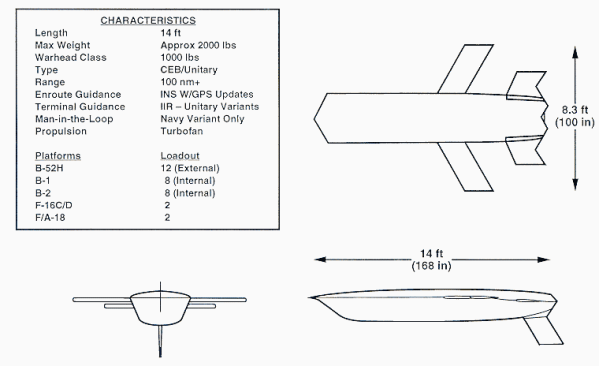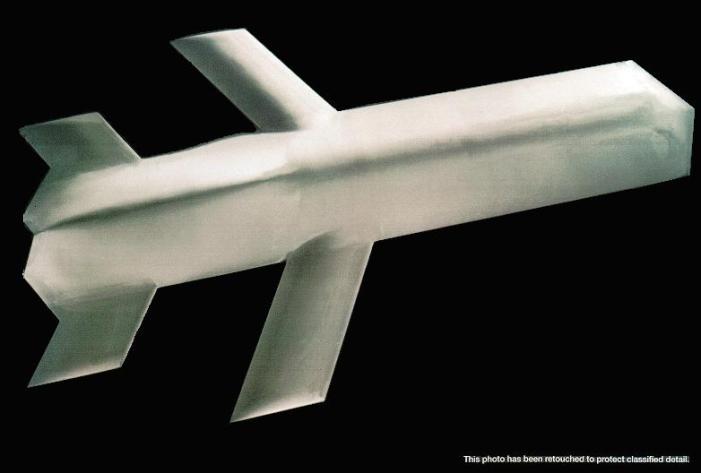Northrop AGM/MGM-137 TSSAM
In 1986, the U.S. Air Force began to develop the then highly classified TSSAM (Tri-Service Standoff Attack Missile), a stealthy cruise missile with autonomous guidance and target recognition systems. The USAF and U.S. Navy were to use the air-launched AGM-137A variant, while the U.S. Army would use the ground-launched MGM-137B. It was not until 1991 that the existence of the TSSAM was officially revealed, but very few details were given.
The airframe design of the TSSAM was based on that of Northrop's TACIT BLUE stealth test aircraft turned upside-down. It was powered by a Williams F122 turbofan, but details of the intake and exhaust configuration remain classified. It can be assumed that the wings and tail surfaces of the missile were foldable. The missile used a GPS-aided inertial navigation system for midcourse guidance. The TSSAM was designed as a modular weapons system, and items like terminal guidance system and warhead were configurable depending on the version and mission.
 |
| Drawing: Northrop Grumman |
| AGM-137A |
The primary USAF and Navy version of the AGM-137A had a unitary penetrator warhead in the 450 kg (1000 lb) class for use against hardened targets. The USAF also planned an alternative cluster bomb warhead with BLU-97/B CEB (Combined Effects Bomblet) submunitions against soft targets. For terminal guidance, the unitary warhead variants employed an IIR (Imaging Infrared) seeker which could autonomously search and lock on the target based on pattern recognition algorithms. It is possible that the U.S. Navy variant would have used a two-way data link for man-in-the-loop operation. The Army's MGM-137B was to be launched from a modified M270 MLRS (Multiple Launch Rocket System), and was to carry the BAT (Brilliant Anti-Tank) submunition for use against armoured vehicles.
 |
| Photo: DOD |
| AGM-137A |
Technical problems during development and flight testing, and the overly complicated program structure (caused by the tight secrecy and the program's tri-service status) led to excessive cost overruns. The Army dropped out of the program in early 1993, and developed the MGM-140 ATACMS (Army Tactical Missile System) as the primary carrier for the BAT submunition, leading to the MGM-164 ATACMS II. The air-launched AGM-137 was eventually cancelled in December 1994. Almost immediately after TSSAM cancellation, the Air Force and Navy started the JASSM (Joint Air-to-Surface Standoff Missile) program as a replacement, eventually leading to the development of the AGM-158 missile.
Specifications
Note:Data given by several sources show slight variations. Figures given below may therefore be inaccurate!
Data for AGM-137A:
| Length | 4.3 m (14 ft) |
| Wingspan | 2.5 m (8 ft 4 in) |
| Weight | 900 kg (2000 lb) |
| Speed | subsonic |
| Range | > 185 km (100 nm) |
| Propulsion | Williams F122-WR-100 turbofan |
| Warhead | 450 kg (1000 lb) unitary penetrator; alternative: dispenser with BLU-97/B bomblets |
Main Sources
[1] Hajime Ozu: "Missile 2000 - Reference Guide to World Missile Systems", Shinkigensha, 2000
[2] John Pike: GlobalSecurity.org Website
Back to Current Designations Of U.S. Unmanned Military Aerospace Vehicles
Back to Directory of U.S. Military Rockets and Missiles
Last Updated: 8 October 2002